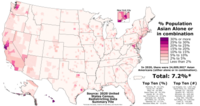
Photo from wikipedia
Garcia and colleagues1 delve into an understudied but vitally important physician workforce concern: professional burnout. Their work draws on a national survey of physicians with a sample large enough to… Click to show full abstract
Garcia and colleagues1 delve into an understudied but vitally important physician workforce concern: professional burnout. Their work draws on a national survey of physicians with a sample large enough to examine differences in important metrics by race/ethnicity. Given the long-standing struggle to improve the diversity of the medical profession, examining the extent of burnout among physicians of minority racial/ethnic groups is imperative. As Garcia and colleagues1 note, their findings may be counterintuitive to some. Multivariable models adjusting for specialty, workload, practice setting, age, and sex show that physicians in minority racial/ethnic groups (ie, Hispanic/Latinx, non-Hispanic Black, and non-Hispanic Asian physicians) had considerably lower rates of burnout than their White counterparts. Given the literature on experiences of discrimination and career pressures among Hispanic/Latinx, Black, and Asian physicians,2 one might expect more, not less, burnout. How can this be? We need first to consider the possibility that this result may not truly reflect better practice circumstances or more resilient personal characteristics of these physicians. Although the data used by Garcia and colleagues1 have strength in their national scope and detailed measures, the sample sizes are not large enough to enable full disentangling of the association between race/ethnicity and burnout. Garcia and colleagues1 use multivariable models to control for key cofactors to isolate the independent association between race/ethnicity and burnout, but such modeling can also mask important associations. We believe that controls for practice specialty are especially suspect in this regard. Prior work has shown that primary care physicians experience more burnout than specialists3 and that physicians of minority racial/ethnic groups are more likely to practice primary care.4 Therefore, it could be that controlling for specialty in the multivariate model masks the extent of burnout experienced by physicians from underrepresented groups compared with their White counterparts. If this is so, the findings of the study by Garcia and colleagues1 are less comforting. It is critical that future studies use large data sets with modeling approaches like nesting, stratification, or interaction terms to disentangle these and possibly other critical associations. Although nationally representative surveys are important tools for understanding workforce dynamics, studies relying on survey research must be carefully scrutinized. Survey research has become extraordinarily challenging, particularly because response rates have steadily declined. One cannot automatically infer bias from low response rates, and surveys remain important tools for assessing workforce stress; however, going forward, research techniques that include analysis of administrative records and in-depth qualitative methods should be used to complement surveys. Methodological issues aside, if we accept that physicians in minority racial/ethnic groups demonstrate less burnout than White physicians, the search for protective factors is important. Drawing on a cross-sectional study at a single point in time, Garcia and colleagues1 note that their research can serve only to raise hypotheses that may explain these differences. For example, they suggest that their finding of more favorable reports of work-life balance among Black physicians supports the idea that Black physician resilience is bolstered by stronger family support. They also posit that workforce dynamics, possibly stemming from greater early attrition among medical students and physicians of minority racial/ethnic groups, selects for more resilient physicians from + Related article
Journal Title: JAMA network open
Year Published: 2020
Link to full text (if available)
Share on Social Media: Sign Up to like & get
recommendations!